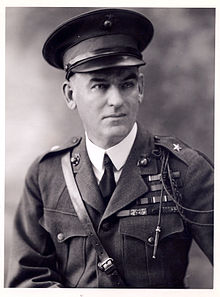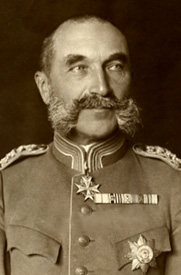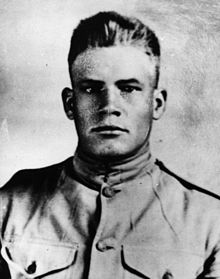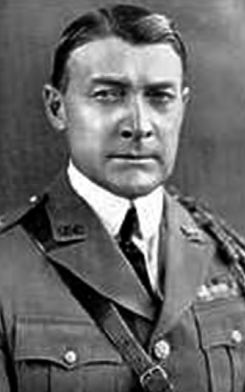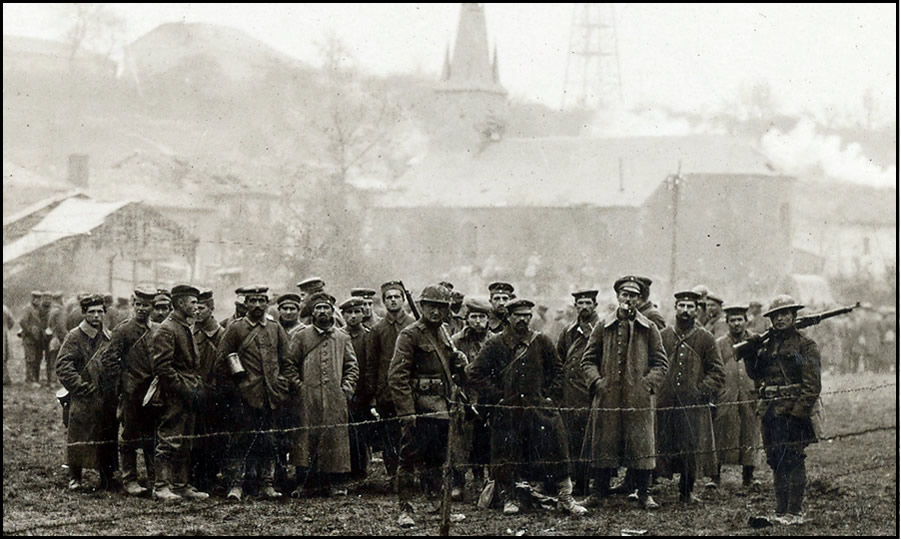Blanc Mont Bunker
Scheduled to jump off at 6:00 in the morning (the day begins gray and misty), the artillery of Brigadier General Albert Bowley opens up on the German lines ten minutes before the scheduled advance is to begin, with guns targeting the ridge and others beginning the rolling bombardment screening the attackers as it moves towards the high ground in four minute increments. Surprise, shells, and the "esprit" of the men involved combined just as Leguene had planned, and before the afternoon is over, both wings of the attack are atop Blanc Mont Ridge (the French military hero, General Henri Philippe Benoni Omer Petain, before becoming one of the many traitorous WWII boot lickers of Adolf Hitler, will describe the attack as the greatest Allied accomplishment of 1918), all first day objectives have been taken, and the Americans have driven a three-mile deep salient into the German line. It is an accomplishment made possible by men like Chicago born 20-year-old Marine Private John Joseph Kelly, 22-year-old Marine Corporal John Henry Pruitt of Arkansas, 22-year-old South Carolina Marine 1st Lt. James P. Adams, Boston born Marine 2nd Lt. Edward C. Fowler, 17-year-old Tennessee Marine Private Julian Wesley Alsup, Sioux Falls Marine Private Richard Oakes Jordan, 21-year-old Private Roy H. Beird of Illinois, Marine Private Bruce H. Mills, Austria born 31-year-old Marine Private Samuel Glucksman, Marine Private Lambert Bos of Idaho, 21-year-old Marine 2nd Lt. Hugh Pratt Kidder of Minnesota, Marine Private Samuel Slokom Simmons of Pennsylvania, Marine Private Joe Nichols Viera of Nevada, Knoxville Marine Corporal Henry W. Philblad, 23-year-old Marine Sgt. Henry S. Bogan from Kentucky, 22-year-old Marine Pharmacist's Mate First Class John Henry Balch from Kansas City, and others of their ilk.
*Kelly, having promised companions that he will be the first to capture a machine-gun, in advance of his own line, runs over 100-yards through the falling shells of the 2nd's opening barrage and takes out a machine gun nest, killing one German with a grenade, another with a pistol, and then returning through the barrage with eight prisoners in hand ... a morning which wins him the Medal of Honor (before the war is over he will also win five silver stars and two Purple Hearts).
*Pruitt wins the Medal of Honor taking out two machine guns while killing two Jagers, then captures forty more Germans from a nearby bunkhouse (sadly, he is killed by an exploding shell during the following day's counterattacks by the Germans).
*Adams voluntarily leads four soldiers through falling shellfire to take out a machine gun enfilading his company's line, winning a Distinguished Service Cross.
*The evening before the attack, alone, Fowler helps clear the way for his men by crawling into no-man's-land removing a machine gun with grenade. the next morning, he leads his men forward, capturing 15 machine guns and 80 Germans, then to finish the day off, exposed to artillery fire, he snipes another machine gun nest out of existence.
*Their company stopped by enfilading machine gun fire, Alsup, Beird, Jordan, and Mills win Distinguished Service Crosses for volunteering to attack the enemy position, which they take out with grenades and rifle fire, killing three Germans and capturing twenty-five others crewing the defensive position.
*Without aid, Bogan takes out three machine gun nests, and though wounded in the process, takes thirty Germans prisoner, then escorts them to the rear by himself so as not to weaken the American line, gaining Oak Leaves for the Distinguished Service Cross he already possesses.
*Bos wins the Distinguished Service Cross eliminating a machine gun nest with two other volunteers, treats a wounded comrade, captures two more machine guns, captures fourteen men manning the position he is attacking, and then for good measure, captures forty more Jagers in a nearby dugout.
*Forcing a captive to lead him to the dugout the German came from, Glucksman captures twenty more men, returns them to the rear, and then despite wounds, returns to the front and continues the fight until he collapses from blood loss, actions that win him a Distinguished Service Cross.
*By himself, Philbad captures two machine gun nests, killing the position's Germans, then a few hours later he takes on another nest is killed by an explosion of shrapnel, winning a posthumous Distinguished Service Cross.
*The Distinguished Service Cross Simmons wins comes by way of helping wipe out a machine gun nest, capturing forty Germans from a dugout, and carrying three messages to the rear through a German artillery barrage.
*Viera's busy Distinguished Service Cross morning comes from helping capture three machine guns, and taking forty German prisoners out of a dugout.
*Balch receives a Medal of Honor for establishing an aid station for wounded Americans during a German artillery barrage.
*Losing his life, but winning a Distinguished Service Cross, Kidder in 24-hours helps capture six machine guns, take men prisoner from the multiple positions, aids two wounded Americans, and is killed trying to gain a better position during a German counterattack.

Unfortunately though for the Allied soldiers on the ridge, the French on both sides of the attack falter, and the rest of the day and evening, the men of the 2nd Division are peppered by German counterattacks and artillery fire as the French order the division to continue attacking northward. Ordered to advance by French XXI Corps commander, Major General Stanislaus Naulin, and take the village of Machault (six miles beyond the American lines), Lejeune balks and insists on going after a closer objective, being allowed to bring his artillery forward, and that his guns be fully resupplied with ammunition. Pleased that the ridge is finally out of the German's hands (though the area is full of bypassed strong points that still must be reduced), Naulin backs down and once again the Marine general is allowed to run his own operation which consists of an advance on the high ground about a mile south of the abandoned town of St. Etienne. Mauled moving forward from both flanks (at one point men will report being fired on from the north, south, east, west, and above as German fighters control the skies above Blanc Mont Ridge and more harm comes from one unit moving forward off schedule and without any artillery support), the attack gains many of its stated objectives, but without support from the still lagging French, by evening the Americans have been pushed back into their starting positions of the morning (a retreat called for by wounded Captain Dewitt Peck almost turns into a rout as units become mixed in the intense German gunfire and officers have to stop running to the rear men with their pistols ... the only known retreat of WWI by the Marine Corps), suffering more casualties than took place assaulting and taking the ridge (the day stands as the worst for the Marine Corps during WWI as Leguene's men suffer 1,889 casualties with one of the worst hit units being the 1st Battalion of the 6th Regiment which starts the day with 800 officers and men, and ends it with only 168 men answering evening roll call ... and among the dead are two previous Medal of Honor winners, 2nd Lt. Henry L. Hulbert and Sergeant Matej Kicak). Identifying one of the German's most worrisome positions being a series of strong machine gun nests to the west of Blanc Mont Ridge, his guns now moved forward and resupplied, Bowley's artillery spends the evening pummeling the positions, and when dawn breaks, the machine gun nests receive another dose that is backed up by a rolling barrage that covers the American attack ... an attack that shows off how successful Legeune tactics can be when applied properly as the Marines, without losing a single man, capture 200 Germans and 75 machine guns. On the right of the salient, unsupported by the French, the men of the 23rd Infantry Brigade remained stalled throughout the day.Naulin
Bowley
Despite the obvious evidence of the difference preparation makes in success of an attack, Naulin keeps pressuring the American general to continue his advance the following day. After another heated debate, Legeune agrees to a compromise; the 5th of October will be used to bring separated units together and resupply them, and to clean out bypassed German strongpoints, with the northward advance to be renewed on the morning of the 6th. Starting at 5:30 in the morning as planned, General Bowley's guns drop artillery fire on the forward German positions for an hour, and then the American brigades move forward behind a rolling barrage. Three hours later both units have closed on the south side of the St. Etienne-Orfeuil Road. All goals and more accomplished but troops exhausted, Lejeune has the 142nd Infantry Regiment relieve the 4th Marine Brigade and the 141st Regiment relieve the 3rd Infantry Brigade, but leaves one battalion from each relieved brigade behind (along with most of his machine guns and mortars in place) to stiffen up the replacements. The Marine commander requests a couple of days to get his green troops ready for another attack, but Naulin is on him again demanding the forward attacks continue. Pattern repeated, Lejeune protests, Naulin insists, and so the Americans organize for another advance ... and the Germans are waiting, aggressively fighting back so that the rest of their line can retreat to a new line of defensive positions. On October 8th when the American guns fire on the German lines, prior to the attack beginning, counter-fire, including toxic gas rounds, are sent at the 141sst and 142nd, and the advance ends almost instantly, with only the veteran battalions experiencing any success as one unit digs in on the north side of the town of St. Etienne, allowing the 142nd to move up, while the other Marine battalion on the right, launching a fierce counter-attack into the German flank that pushes the American line north of the St. Etienne-Orfeuil Road, accomplishments that cost the 71st Infantry Brigade more than 1,300 causalities on the October 8th (4,821 casualties over the course of the battle ... by contrast, the bloody three-day Battle for Tarawa during WWII in the Pacific costs the Marine Corps 3,110 casualties).
Downtown St. Etiennie
The next two days find the Americans consolidating their line while ammunition and supplies are moved up, and exhausted troops are moved out, with the remainder of the 2nd Division's unrelieved soldiers finally pulled off the line. Key position in the line taken and held with the fall of Blanc Mont Ridge, on the 10th, the Germans begin a general withdrawal from the area to other defensive positions along the Aisne River. The Siegfried Line in the Champagne region broke, the 2nd's main contribution to winning the war completed (though no one knows it at the time) and Lejeune's command is pulled back to the Suippes-Somme-Suippes area for refitting and rest, before moving to the Triaucourt area and establishing it's headquarters at Conde-en-Barrios, where they are on November 11, 1918, when the war ends. The unit's accomplishment in taking the difficult position noted by the French, Germans, and Americans (echoing British King Henry V's speech prior to the Battle of Agincourt, Lejeune will state after the battle, "To be able to say when this war is finished, I belonged to the SECOND DIVISION, I fought with it at Blanc Mont Ridge, will be the highest honor that can come to any man.") after the war memorials and monuments go up on the battlefield that honor the bravery of the men that fought there over a hundred years ago, the largest being an ossuary of the remains of 10,000 soldiers that fought on the fields of Champagne honoring French and American troops, mounted by a huge statue created by artist Maxime Real del Sarte depicting French troop commander General Henri Joseph Eugene Gouraud (on his death in 1946, at his own personal request, Gouraud is buried in the structure with some of the men he once commanded), American airman and President Theodore Roosevelt's son, Second Lieutenant Quentin Roosevelt (killed over dogfighting over Chamery at the age of 20), and del Sarte's brother, who is killed in the fighting around Champagne. And there is also a large memorial approved by the American Battle Monuments Commission on Blanc Mont Ridge honoring the Americans of the 2nd, 36rd, 42nd, and 93rd U.S. Divisions that fought alongside the French in the Champagne region.
Dedication
Atop The Ossuary
A hideous testing ground for the Marines, among those at Blanc Mont Ridge that survive the ordeal, Wendell Cushing Neville of the 4th Brigade will win a Medal-of-Honor at Vera Cruz and in 1930, becomes the new Commandant of the United States Marine Corps (he dies that same year at the age of 60), Logan Feland of the 5th Regiment will go on to win five silver stars for bravery and become a major general in charge of the Department of the Pacific before dying at the age off 66 in 1936), Henry Louis Larsen of the 3rd Battalion will serve in the Marine Corps until 1946, winning two Navy Crosses and three Silver Stars while becoming a Lieutenant General, and the military governor of America Samoa and Guam, while commanding over 215,000 personnel during WWII (he dies in Denver, Colorado in 1962 at the age of 71), Harry Lee of the 6th Regiment will go on to become a major general and command the Marine Corps Base at Quantico, Virginia (he dies on the base in 1935 at the age of 62), and Littleton Waller Tazewell Waller, Jr. of the 6th Machine Gun Battalion will attain the rank of major general while serving as Marine Corps Director of Personnel during WWII (he dies in Willow Grove, Pennsylvania in 1967 at the age of 80).
2nd Division Memorial On Blanc Mont Ridge
The most famous participant in the battle though is of course, John Archer Lejeune, often referred to as "the greatest of all Leathernecks." A major general at the time of the Battle of Blanc Mont Ridge, Lejeune will go on the serve eleven more years in the Marine Corps (in all, he spends 39-years as a Marine before retiring in 1929), rising to the rank lieutenant general, becoming the 13th Commandant of the Marine Corps (1920 to 1929), and founding the United States Marine Corps League for veterans in 1926. After retiring from the Marine Corps, Lejeune becomes the 5th superintendent of the Virginia Military Institute (VMI) in Lexington, Virginia (1929 to 1937). The message he sends to the Marine Corps in 1921, is now read annually on the Corps celebration of it's birthday on 11/10. There are statues of the man on the grounds of the Pointe Coupee Parish Courthouse in New Roads, Louisiana, outside of the National Museum of the Marine Corps in Triangle, Virginia, in the center of the traffic circle at the Camp Lejeune Marine Corps Base in Camp Lejeune, North Carolina, outside Lejeune Hall on the campus of the United States Naval Academy, outside of Lejeune Hall on the Quantico Marine Corps Base, and next to the United States destroyer USS Kidd in downtown Baton Rouge, Louisiana at the Louisiana War Memorial. Lejeune's name is also on a naval transport ship (AP-74), a hall on the campus of LSU, a high school in Jacksonville, North Carolina, and on Lodge No. 350 of the Ancient, Free, and Accepted Masons of Quantico, Virginia. Lejeune passes away at the Union Memorial Hospital of Baltimore, Maryland on November 20, 1942 at the age of 75. With full military honors, the Marine Corps general is interred at Arlington National Cemetery (Section Six, Grave 5682).
Lejeune will have a U.S. postal stamp issued in his honor in 2005.
At Arlington
New Roads, Louisiana
The United States Marine Corps' battle for Blanc Mont Ridge begins ... October 3, 1918
Medal of Honor Winner Kelly At Blanc Mont Ridge
- October 3, 1918
Members of the 2nd Division
.


































